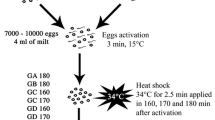Abstract
Eggs from crosses of 40 adult male R. prolixus irradiated with 6K rad γ-rays with normal females had a mean fertility of 23.9%, only 2 crosses being completely sterile. The 86 F1 progeny of both sexes, when outcrossed with normal mates, had a mean egg fertility of 12.6%, and 43 of these matings were completely sterile. Twenty-eight “F2” bugs reared from F1 x normal crosses were mated with normal partners and had a mean fertility of 44.6%, 6 of them being fully fertile, a reversal towards normal fertility. Cytogenetic examination of F1 “F2” and “F3” males showed that these changes in fertility correlated well with the degree of chromosomal abnormality found. The very high recovery rate of translocations in F1 generation males can be related to the holocentric chromosomes of these bugs which precludes the formation of dicentric chromosomes which are inviable in monocentric species. In F1 and “F2” males the majority of translocations were associated as chains of III+I or as chains of IV. Only one bug was found with a ring of IV chromosome association and it is suggested that chromosome morphology, combined with a low chiasma frequency, favours chain association. Most chain multivalents showed linear orientation which may lead to duplication deficiencies and zygotic death. However “parallel”, “indifferent” and the more stable “convergent” modes of chain orientation were also all observed indicating that survival of some translocations in this species may be possible. The survival to the “F2” generation of chromosomal fragments confirmed the holocentric nature of triatomine chromosomes. It is suggested that semi-sterile males would prove more effective than releases of completely sterile males for reducing wild populations of R. prolixus, because of the delayed effects of sterilizing radiation consequent upon the holocentric structure of triatomine chromosomes.
Similar content being viewed by others
References
Abbott, W.S.: A method of computing the effectiveness of an insecticide. J. econ. Ent. 18, 265–267 (1925)
Baldwin, W.F., Chant, G.D.: Use of nitrogen during irradiation to improve competitiveness in sterile males of Rhodnius prolixus. IAFA-SM-138/1 (1970)
Baldwin, W.F., Shaver, E.L.: Radiation-induced sterility in the insect Rhodnius prolixus. Canad. J. Zool. 41, 637–648 (1963)
Bauer, H.: Die kinetische Organisation der Lepidopteren-Chromosomen. Chromosoma (Berl.) 22, 101–125 (1967)
Borstel, R.C. von: Population control by release of irradiated males. Science 131, 880–882 (1960)
Buck, R.C.: Mitosis and meiosis in Rhodnius prolixus: The fine structure of the spindle and diffuse kinetochore. J. Ultrastruct. Res. 18, 489–501 (1967)
Buxton, P.A.: The biology of a blood-sucking bug, Rhodnius prolixus. Trans. R. ent. Soc. Lond. 78, 227–236 (1930)
Cox, D.R.: Analysis of binary data. Chapter 3: The empirical logistic transform. Methuen monographs of applied probability and statistics. London 1970
Curtis, C.F., Langley, P.A., Mews, A.R., Offori, E.D., Southern, D.I., Pell, P.E.: Sex ratio distortion and semi-sterility in the progeny of irradiated Glossina morsitans. Genet. Res. 21, 153–165 (1973)
Davidson, G.: Genetic control of insect pests. London and New York: Adademic Press 1974
Friend, W.G., Choy, C.T.H., Cartwright, E.: The effect of nutrient intake on the development and egg production of Rhodnius prolixus Stal. Canad. J. Zool. 43, 891–904 (1965)
Gomez-Nuñez, J.C., Gallimore, J., Fernandez, M., Gross, A.: El efecto de las radiaciones ionizantes sobre la Biologia y la Ecologia de Rhodnius prolixus, vector principal de Schizotrypanum cruzi en Venezuela. Acta cient. venez. 13, 46–52 (1962)
Gomez-Nuñez, J.C., Gross, A., Machado, C.: Las radiaciones gamma y el comportamiento reproductivo del Rhodnius prolixus macho. Acta cient. venez. 15, 97–104 (1964)
John, B., Claridge, M.F.: Chromosome variation in British populations of Oncopsis (Hemiptera: Cicadellidae). Chromosoma (Berl.) 46, 77–89 (1974)
John, B., Lewis, K.R.: The meiotic system. Protoplasmatologia. Bd. VI F1. Wien: Springer 1965
Kirby-Smith, J.S., Daniels, D.S.: The relative effects of X-rays, gamma rays and beta rays on chromosomal breakage in Tradescantia. Genetics 38, 375–388 (1953)
Knipling, E.F.: Possibilities of insect control or eradication through the use of sexually sterile males. J. econ. Ent. 48, 459–462 (1955)
Knipling, E.F.: Suppression of pest Lepidoptera by releasing partially sterile males. Bioscience 20, 465–470 (1970)
LaChance, L.E., Degrugillier, M.: Chromosomal fragments transmitted through three generations of Oncopeltus (Hemiptera). Science 166, 236–237 (1969)
LaChance, L.E., Degrugillier, M., Leverick, A.P.: Cytogenetics of inherited partial sterility in three generations of the larger Milkweed bug as related to holokinetic chromosomes. Chromosoma (Berl.) 29, 20–41 (1970)
Lewis, K.R., John, B.: Chromosome marker. London: J. and A. Churchill 1963
Lyon, M.F., Meredith, R.: Autosomal translocations causing male sterility and viable aneuploidy in the mouse. Cytogenetics 5, 335–354 (1966)
Maudlin, I.: The inheritance of susceptibility to Trypanosoma cruzi infection in Rhodnius prolixus. Nature (Lond.) 262, 214–215 (1976)
North, D.T., Holt, G.: Inherited sterility in progeny of irradiated male cabbage loopers. J. econ. Ent. 61, 928–931 (1968a)
North, D.T., Holt, G.: Genetic and cytogenetic basis of radiation induced sterility in the male cabbage looper, Trichoplusia ni. In: Isotopes and Radiation in Entomology (Symp. Nov. 1967), p. 391–403 IAEA (1968b)
Proverbs, M.D.: Progress on the use of induced sexual sterility for the control of the codling moth, Carpocapsa pomonella (L.). Lepidoptera: Olethrentidae. Entomol. Soc. Ontario, 92, 5–11 (1962)
Proverbs, M.D., Newton, J.R.: Some effects of gamma radiation on the reproductive potential of the codling moth, Carpocapsa pomonella (L.). (Lepidoptera: Olethrentidae). Canad. Ent. 94, 1162–1170 (1963)
Searle, A.G., Evans, E.P., Ford, C.E., West, B.J.: Studies on the induction of translocations in mouse spermatogonia. I. The effect of dose rate. Mutation Res. 6, 427–436 (1968)
Snell, G.D.: An analysis of translocations in the mouse. Genetics 31, 157–180 (1946)
Ueshima, N.: Cytotaxonomy of the Triatominae (Reduviidae: Hemiptera). Chromosoma (Berl.) 18, 97–122 (1966)
Walker, D.W., Quintana, V.: Inherited partial sterility among survivors from irradiation-eradication experiments. J. econ. Ent. 61, 318–319 (1968)
Author information
Authors and Affiliations
Rights and permissions
About this article
Cite this article
Maudlin, I. The inheritance of radiation induced semi-sterility in Rhodnius prolixus . Chromosoma 58, 285–306 (1976). https://doi.org/10.1007/BF00292095
Received:
Accepted:
Issue Date:
DOI: https://doi.org/10.1007/BF00292095




